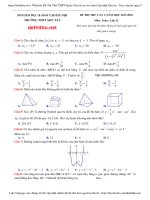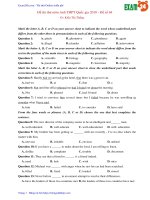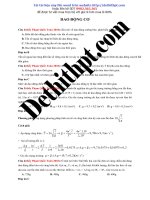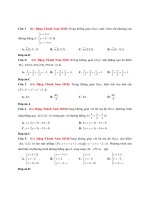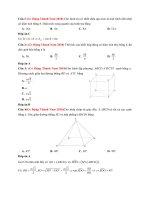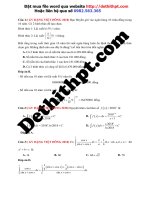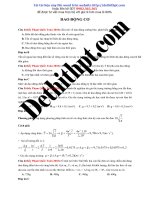Cs224W 2018 64
Bạn đang xem bản rút gọn của tài liệu. Xem và tải ngay bản đầy đủ của tài liệu tại đây (4.56 MB, 10 trang )
Link Prediction with Enclosing Subgraph
Zihuan Diao
Stanford University
353 Serra Mall, Stanford, CA 94305
Abstract
Link predication is a classical task in the field of network analysis. A good link
prediction model would be useful in building a recommendation system that could
be applicable in social networks and online shopping sites. There are two main
ways to tackle the link prediction problem, one is based on ranking links based
on heuristics of their end nodes,
and the other is to transform the problem into
a supervised learning problem and train machine learning models to predict link
formations. In this paper, we will survey previous publications on the topic of link
prediction and propose a new supervised learning model to solve this problem.
1
Introduction
The goal of link prediction is that given a graph to predict the new edges that would form in the
future or the missing edges in the present observation. Studying the link prediction problem could
help us understand the underlying dynamics of the network, and therefore there are many existing
work around this topic. There are two main types of approaches researchers take to tackle the link
prediction problem, one is using unsupervised methods and the other is to formalize the problem
as a supervised machine learning problem and build a model to predict link formation. For the
supervised learning methods, the main idea is to transform the link predicting problem into a binary
classification problem. The problem is defined as given two nodes in the base graph that don’t have
an existing edge between them, predict whether an edge would form between them given some input
features.
A link’s formation is determined both by its end nodes’ local and global network structures. In
order to capture the local network structure, the enclosing subgraph of a candidate link is used,
and it is defined to be a fixed-size subgraph containing multi-hop neighbors of both end nodes.
Enclosing subgraph with its nodes’ features extracted from the original network would help include
both local and global network characteristics. In the project, we will explore existing solutions
as the baseline and develop a enclosing subgraph based supervised learning model. The model
would extract features based on the enclosing subgraph of the two end nodes and train an binary
classification model using those features. We also evaluate the performance of the model and analyze
the result for future improvements.
2
Related Work
There are many existing publications related to the topic of link prediction, and we present you some
of those papers that contribute to the ideas in this paper.
2.1
Heuristic Methods
David Liben-Nowell and Jon Kleinberg formlize the problem of link prediction in a network and
propose a class of method based ranking with similarity scores of the end nodes of a potential link.[1]
The link prediction problem ¡is defined as given a graph Œ = (V, F} at time stamp ¿, we would like
to predict new edges that would form from ¢ to a future time stamp t’. Also, in this problem setting,
the link predication problem only focuses on the new edges whose end nodes existing in the graph
at t.
Using the intuition that two entities in the social network are more likely to interact with each
other if they share many common neighbors. The authors propose using heuristics to measure the
similarity between the two end nodes X, Y and rank all candidate edges using this similarity score
score(X,Y) of their end nodes. The authors experiment with three different kinds of similarity
scores such as common neighbors, Jaccard’s coefficient, Katz, PageRank, and SimRank. The paper
shows that the similarity score based method could greatly improve the link predication performance
comparing to a random model.
2.2
Supervised Learning Methods
After David and Jon presented the link predication problem in their paper[1], a new suite of machine learning method is introduced to solve the problem. Mohammad AI Hasan and the coauthors
formalize the link prediction problem as a binary classification problem and use supervised learning
models to solve it.[2] The problem is defined as taking node pairs in the training graph where no
edge appear between them as input data points, and the label for the classification is defined to be
whether the node pair has an edge in the testing graph.
For each of the node pairs, the model extracts three kinds of features: proximity features based on
the extra information in the dataset, aggregated features, and topology features. Then, the paper uses
different machine learning models to build a classification model using these features. Some of the
models in this paper are decision tree, SVM, KNN, and Bagging. The paper evaluates the result of
each models following the common practice for the general classification models, using Accuracy,
Precision, Recall, F-value and Squared Error. The paper shows some promising F-value for most of
the models.
2.3.
Enclosing Subgraph
Jumping to the recent years, Muhan Zhang and Yixin Chen introduce a new idea for supervised
learning in link prediction in their paper using enclosing subgraph.[3] Instead of focusing on the
two end nodes for the candidate link, this paper propose we look at the enclosing subgraph of fixed
size k for the link. The enclosing subgraph is defined as the graph containing only nodes that are
n-hop neighbors of the end nodes for the candidate edge where we will start from n = 1 until we
have enough nodes to reach size k.
The Weisfeiler-Lehman Neural Machine models works
date link, the model extract the enclosing subgraph of a
using Pallette-WL algorithm[3]. Then, it generates an
ordering and feed the flattened adjacency matrix as the
evaluates the model’s performance on 8 networks, and
to most of the baseline models.
3
in the following way. First, for each candisize k, and orders the nodes in this subgraph
adjacency matrix for the subgraph using the
input feature to a neural network. The paper
the model achieves higher AUC comparing
Dataset
In this project, we will be working with the undirected collaboration network derived from DBLPCitation-network V10 [4]. This network contains papers extracted from the DBLP database where
publication’s date is from 1940 to 2018. In this dataset, there are 3,079,007 publications, 1,766,547
unique authors, and around 14,724,453
edges is an estimate as we are including
authors, and edges are shown in figure
increase as time progresses. Based the
whose size is feasible for this project.
collaboration edges between authors.
duplicate edges. The distribution of
1. We could find that the numbers
distribution over the years, we could
Note that the count for
the publications, active
of all these three items
then select a subgraph
In this paper, we will be studying the collaboration relationship between authors. Therefore, the
nodes in our graph would be unique authors, and the edges denotes whether two authors has collaborated or not.
400000
350000.
200000.
300000.
Autnt r Count
Ẹ
3 250000
Š 150000
2
§8
5
5 200000
85 100000
2
A tive
$Š 150000
100000
50000
50000
041
1940
o4
1960
1940
1960
1980
Year
2000
2020
(b)
1600000
1400000
1200000
1000000
>
800000
600000
400000
200000
ot
1940
1960
1980
Year
2000
2020
(c)
Figure 1: (a) paper distribution, (b) active author distribution, (c) collaboration edge distribution
Table 1: Graph construction parameters
PARAMETER
authors in ¢;
VALUE
base graph to to ty
prediction graph t; + ltotg
3.1
1995
from 1995 to 1999
from 2000 to 2004
Preprocessing
Due to the huge size of the original network, we
project. To extract the subgraph, we find a period
paper during t;. This set of authors V would be
graph. We will then pick a suitable year range
would only be using a subset of the network in this
of time ¢; and extract all the authors that published
the set of nodes for our base graph and prediction
from to to t, to construct the base graph G' with
nodes in V, and we will then find a year tz such that tg > t,, and record the graph from to to tg
minus the new nodes and existing edges in the base graph which will be the prediction graph G.
The parameters used to construct the base graph and the prediction graph are shown in table 1.
In addition to choosing a reasonable graph size, we also remove nodes with degree less than 3 when
constructing the base graph and the prediction graph. This is based on the idea that nodes with
degree less than 3 have little information for us to make a informed prediction.
We randomly select 60% of the edges in the prediction graph as training set, 20% as validation set,
and 20% as test set. In order to make the dataset applicable for both the similarity score base methods and supervised learning method, we will add the same number of randomly sampled negative
sample, which means node pair that does not have edges in the base and prediction graph, to each
of the dataset.
Table 2: Base Graph Characteristics
PARAMETER
VALUE
Nodes
Edges
Clustering coefficient
Number of weakly connected components
Edges in the largest weakly connected component
Nodes in the largest weakly connected component
26431
75691
0.632587
799
68151
22335
Table 3: Prediction Graph Characteristics
3.2
PARAMETER
VALUE
New edges
Fraction of new edges
18623
sere = 0.1975
Dataset Characteristics
After extracting the two graphs that we will be working on, we study the characteristics about the
graphs. For the base graph, we could find the degree distribution shown in figure 2. Also, other
graph characteristics could be found in table 2.
Proportion of Nodes with a Given Degree (log)
Proportion of Nodes with a Given Degree
0.25
0.20
0.15
0.10
0.05
107?
10”2
10-3
0.00
0
10
20
30
40
Node Degree
(a)
50
60
109
101
Node Degree (log)
(b)
Figure 2: (a) Degree distribution for base graph, (b) degree distribution for base graph (log-log scale)
We could find
Looking at the
to form closely
component, we
4
4.1
that for the base graph, the majority of the nodes have a degree of less than 10.
clustering coefficient, we notice that it is around 0.6 meaning that the graph tend
tied subgraphs. Also, based on the size of the of the largest weakly connected
find that the majority of the graph is connected.
Method
Similarity Score Heuristics
In this section we will define the similarity scores of two nodes that will be used in the project.
The similarity scores are used both in the ranking based unsupervised methods and the supervised
methods as input features. The similarity score between node A and node B should provide a
similarity measurement that would be a value in R.
Graph distance. The graph distance similarity for A and B would be the negate of the length of the
shortest path between node A and node B.
Common neighbors. First, let’s define I'(A) to be the set of neighbors of node A.
neighbors similarity for A and B would be
The common
[T(A) NT (B)|
Jaccard’s coefficient. The Jaccard’s coefficient[6] for A and B would be
[P(A) NT (B)|
|T(A) UT(B)|
Preferential attachment. The Preferential attachment[8] for A and B would be
[T(A)| - |P(B)|
Adamic and Adar. Adamic and Adar[7] introduce a similarity measure based on the generic features
of two entities. In our link prediction setting, the Adamic and Adar similarity for A and B would
Sm
zer(norcay OBtIE(Z))
Katz. Katz[9] defines a similarity based on the weighted sum of number of paths with certain length
between A and B. In our project, we would be using the unweighted version of this similarity as
the graph we are studying is unweighted undirected graph. The Katz similarity between A and B
would be where Ø is damping parameter
CO
» Ø! - |patha.n|
I=0
This similarity could also be expressed in the matrix form with the adjacency matrix M,
(I—8M)
4.2
}1—T
Edge Embedding
Edge embedding refers to ways that characterize a potential edge to a fixed-size feature vector.
Node2vec[10] is a node embedding algorithm that utilizes parametric random walk specified with
two parameters p and q. In this project, we would use node embedding from node2vec and generate
edge embedding to perform link prediction.
For a candidate edge e with end nodes n; and ng. We could use a node2vec algorithm with p = 1
and q = 0.5 to get a node level embedding of size 64. The idea is that with p = 1 and q = 0.5,
the node2vec random walk would be more BFS-like thus letting the embedding capture structural
similarity. After getting embedding for the two node n, and m2, we then use the Hadamard product
of the two nodes’ embedding as the embedding for e, as Hadamard product has yielded better performance in experiments performed with node2vec[10]. The edge embedding used in the project is
a vector of size 64.
4.3
Enclosing Subgraph
One of the key idea in this project is to incorporate rich information from the candidate links’
surrounding subgraph to help the model predict link formations. For node A and B, we define the
enclosing subgraph for the two nodes as the subgraph from the original graph containing only node
in set EN where EN is constructed using the following algorithm[3]. Note that instead of getting
subgraph with a fixed size k, we could also extract subgraph that only contains 1-hop to k-hop
neighbors of the end nodes.
The other challenge with using information from the enclosing subgraph is how to
formation. One idea would be to aggregate the node level features into a fixed size
subgraph. For instance, we would extract node features and sum them into a features
subgraph. The other way would be to order the nodes and concatenate each node’s
encode
feature
vector
features
the infor the
for the
into a
Algorithm 1 Enclosing Subgraph Extraction
Input link(A, B), size k, graph G
Output EN for (A, B)
F=A,B
EN=0
while |EN| < k do
F=([Userl(v)] \ EN
ENN=Ff
end while
return EN
(a)
(b)
Figure 3: (a) Sample Graph, (b) subgraph of size 5 for node a and b
large subgraph feature vector. In this project, we will focus on a method that is in the middle. We
will aggregate the node features by taking the average within groups of nodes that have the same
minimum distance to the end nodes. Then, we will order the aggregated features according the
groups’ distance to the end nodes. In other words, nodes that are m-hop neighbors to the end nodes
would be treated as a group, and their per node features will be aggregated to generate the features
for this group.
4.4
Baseline
We implement the similarity score based methods as baselines. The similarity score heuristics we
use are introduced in the previous sections. For each of the similarity scores, we will use it to rank
the the testing set node pairs, and the top half of the pairs would be our prediction since the test set
consists of half negative and half positive samples.
4.5
Neural Network with Edge Embedding
The edge embedding defined in the previous section is shown to perform well in link prediction
tasks. For a candidate link, we use its edge embedding as input feature and train a fully connected
neural network to perform binary classification on whether the link will form in the future.
The neural network used in this part has 5 layers with size 64, 32, 8, 4, and 1 where the first 4 layers
has Relu activation functions and the final output layers has a sigmoid activation function.
4.6
Neural Network with Enclosing Subgraph Features
The main goal of the project is explore enclosing subgraph based supervised learning models. We
first extract the enclosing subgraph that contains the 1-hop and 2-hop neighbors of the end nodes and
then get the node2vec features for each node in the subgraph. The configuration for the node2vec
is the same as we used to edge embedding. With the node level features, we encode the features for
Table 4: Method performance on test set
METHOD
PRECISION
Graph distance
Common neighbor
Jaccard’s coefficient
Preferential attachment
Adamic and Adar
Katz with 8 = 0.005
Edge embedding
Subgraph features
Subgraph features w/ Edge embedding
0.6510
0.5519
0.5648
0.6545
0.5498
0.6623
0.7832
0.7573
0.8416
AUC
0.5865
0.5926
0.5888
0.7074
0.5983
0.6133
0.8704
0.8232
0.9190
the subgraph using the techinque introduced in the previous section. We will have subgraph features
of size 2-64 = 128. Finally, we also experiment with concatenating the edge embedding features
to the subgraph features creating a feature vector of size 192.
For the neural network, we decide to use the same fully connected neural network structure as used
in the edge embedding section. The idea is to keep every part of the model the same and only vary
the input features. In this way, we could study if the subgraph features could help with the task of
link prediction.
5
Results
In this section, we present the result of evaluating different methods on the test set. The two metrics
used in the part are the precision and AUC which is the area under the Receiver operating characteristic curve.
ROC curve
1.0 5
0.8 4
xoO
-
vo
0.6 4
8
2
S
a
®
2
0.4 +
ke
0.2 4
⁄
0.0 4
——
——
⁄
0.0
0.2
Edge Embedding
Subgraph Features w/ Edge Embedding
0.4
0.6
False positive rate
0.8
1.0
Figure 4: ROC curve for the edge embedding and subgraph features w/ edge embedding models on
test set
5.1
Performance Analysis
From the precisons and AUC results, we could find that the three supervised learning method using
neural network outperforms the ranking based methods using different similarity heuristics. The
model with only the subgraph features perform the worst among the three while the model with both
subgraph features and edge embedding perform the best.
Moreover, since we are using the same neural network structure and node2vec embeddings for the
edge embedding and subgraph features, we could conclude that the additional features extracted
from the end nodes’ enclosing subgraphs has provided additional information that has imporved
link prediction performances.
5.2
Sample Analysis
In this section, we will examine the samples where an edge embedding model made a wrong prediction but the model with additional enclosing subgraph features made a correct prediction. Analyzing
the samples could help us understand how adding subgraph features help with link prediction.
For the test set, our model using
prediction on 883 samples where
are 506 samples with a label of 1
features has the similar effect on
subgraph features and edge embedding is able to make the right
the edge embedding only model gets wrong. Among them, there
and 377 samples with a label of 0. This indicates that the subgraph
helping the model to predict better on both positive and negative
slit
1597_19717_1
(a)
10954_39705_0
(b)
Figure 5: (a) and (b) are visualization of the enclosing subgraphs of candidate pairs where the
subgraph features improved comparing to edge embedding. (a) is a positive pair, and (b) is negative.
The blue nodes are the end nodes for the candidate link
After
have
ment
Since
have
studying the subgraph structure from the improved samples, we find that most of the samples
a enclosing subgraph that is disconnected. In others words, the samples that show an improveare the ones whose end nodes are far from each other or disconnected in the original graph.
the graph has a large weakly connected components, it is not a common case for samples to
disconnected end nodes or end nodes that are far from each other.
For instance, we could take a closer look at the visualization in figure 5. This is an interesting
observation where we could learn some hints about how subgraph features are contributing to link
prediction. In this case, since we have edge embedding that is based on node2vec, if two end
nodes are close to each other and having a connected enclosing subgraph, then due to the nature of
the random walk in node2vec, the node2vec embedding should be able to capture the correlation
between the two end nodes. Therefore, when the end nodes have connected enclosing subgraphs,
edge embedding could work well on its own. On the other hand, when two end nodes are far from
each other and having a disconnected enclosing subgraph, the node2vec algorithm would be less
likely to capture the correlation between the nodes. However, when incorporate the embedding
from the subgraph, we are essentially looking further from the end nodes and thus getting more
improvements on cases where the two end nodes are having a disconnected enclosing subgraph.
6
Conclusion
In this project, we explored different methods to perform link prediction tasks. We focus on studying
if and how enclosing subgraph features help with link prediction. We find that node2vec is a good
feature to perform link prediction, and we could improve the model using only node2vec features
from the links’ end nodes by incorporating aggregated node2vec features from the links’ enclosing
subgraph. We also study the cases where subgraph features help improve the model’s performance
and come up with a explanation that subgraph features help with link predictions by incorporating
information far away from the end nodes which is particularly helpful in cases where end nodes are
disconnected or have a large distance between them.
7
Future Work
In this project, we focus on using a neural network model to test if enclosing subgraph features
improve the performance on link prediction. The problem with neural networks is that they have
less interpretability comparing to other machine learning models. Therefore, we will have to rely on
analysis on individual samples to reason about enclosing subgraph features’ effects on the task. Testing the enclosing subgraph features by designing different feature extraction and encoding methods
could help shine more light on this topic. Also, building different models with more interpretability
like SVM or decision trees could help improve our understanding on the contribution of enclosing
subgraph on link prediction.
Contribution
This project is done individually by Zihuan Diao. He is responsible for composing the reports
and posters, and also preparing the dataset, building models, designing experiments, and analyzing
results.
Code Repository
/>References
[1] Liben-Nowell, D. & Kleinberg, J. (2003) The Link Prediction Problem for Social Networks. Proceedings
of the Twelfth International Conference on Information and Knowledge Management, pp. 556-559. New York,
NY: ACM.
[2] Al Hasan, M. & Chaoji, V. & Salem, S. & Zaki, M. (2006) Link Prediction using Supervised Learning.
Workshop on Link Analysis, Counter-terrorism and Security (at SIAM Data Mining Conference)
[3] Zhang, M. & Chen, Y. (2017) Weisfeiler-Lehman Neural Machine for Link Prediction.
Proceedings of the
23rd ACM SIGKDD International Conference on Knowledge Discovery and Data Mining, pp. 575-583. New
York, NY: ACM.
[4] Tang, J. & Zhang, J. & Yao, L. & Li, J & Zhang, L. & Su, Z. (2008) ArnetMiner:
Extraction and Mining
of Academic Social Networks. In Proceedings of the Fourteenth ACM SIGKDD International Conference on
Knowledge Discovery and Data Mining (SIGKDD ’2008), pp.990-998
[5] Lecun,
Y. & Bottou, L. & Bengio,
Y. & Haffner,
P. (1998) Gradient-based learning applied to document
recognition. Proceedings of the IEEE, Volume: 86, Issue: 11, pp. 2278-2324
[6] Salton, G. & McGill, M.. Introduction to Modern Information Retrieval. McGraw-Hill,
1983.
[7] Adamic, L. & Adar, E. Friends and neighbors on the web. Social Networks, 25(3):211230, July 2003.
[8] Newman,
M. Clustering and preferential attachment in growing networks.
64(025102), 2001.
[9] Katz, L. A new status index derived from sociometric analysis. Psychometrika,
[10] Grover, A. & Leskovec, J. node2vec:
Physical Review Letters E,
18(1):3943, March
Scalable Feature Learning for Networks.
tional Conference on Knowledge Discovery and Data Mining (KDD), 2016.
10
ACM
SIGKDD
1953.
Interna-

